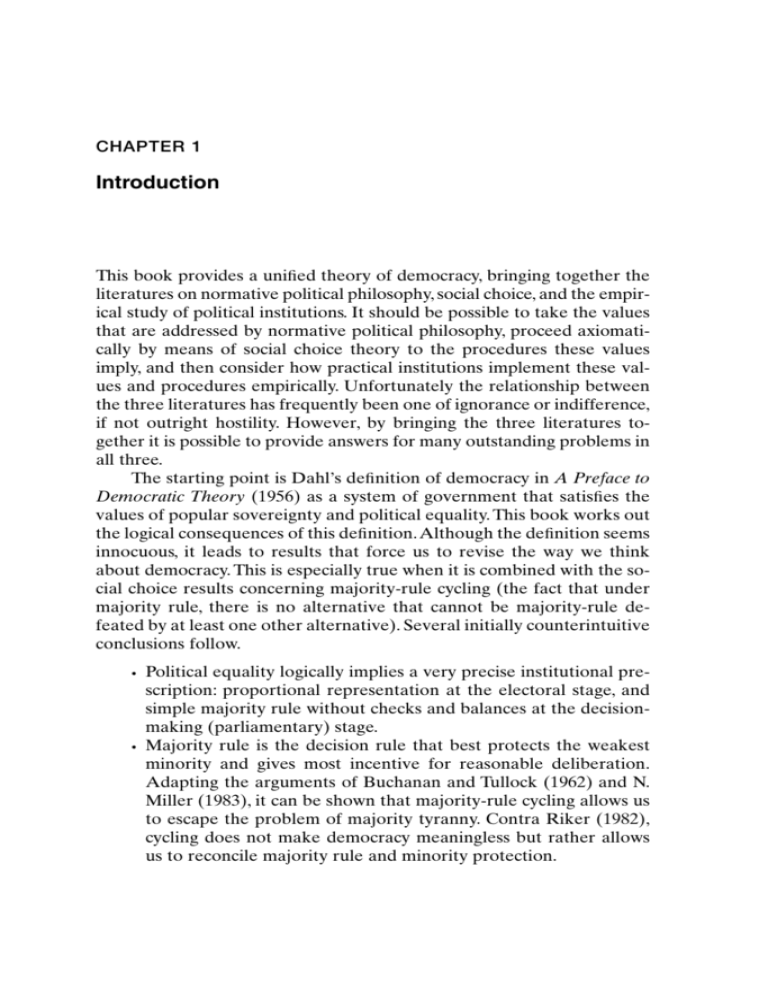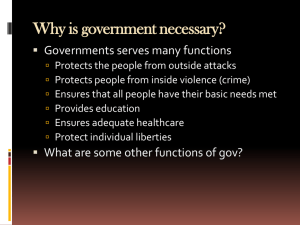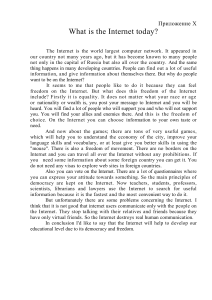Chapter 1
advertisement

CHAPTER 1 Introduction This book provides a uniAed theory of democracy, bringing together the literatures on normative political philosophy, social choice, and the empirical study of political institutions. It should be possible to take the values that are addressed by normative political philosophy, proceed axiomatically by means of social choice theory to the procedures these values imply, and then consider how practical institutions implement these values and procedures empirically. Unfortunately the relationship between the three literatures has frequently been one of ignorance or indifference, if not outright hostility. However, by bringing the three literatures together it is possible to provide answers for many outstanding problems in all three. The starting point is Dahl’s deAnition of democracy in A Preface to Democratic Theory (1956) as a system of government that satisAes the values of popular sovereignty and political equality. This book works out the logical consequences of this deAnition. Although the deAnition seems innocuous, it leads to results that force us to revise the way we think about democracy. This is especially true when it is combined with the social choice results concerning majority-rule cycling (the fact that under majority rule, there is no alternative that cannot be majority-rule defeated by at least one other alternative). Several initially counterintuitive conclusions follow. • • Political equality logically implies a very precise institutional prescription: proportional representation at the electoral stage, and simple majority rule without checks and balances at the decisionmaking (parliamentary) stage. Majority rule is the decision rule that best protects the weakest minority and gives most incentive for reasonable deliberation. Adapting the arguments of Buchanan and Tullock (1962) and N. Miller (1983), it can be shown that majority-rule cycling allows us to escape the problem of majority tyranny. Contra Riker (1982), cycling does not make democracy meaningless but rather allows us to reconcile majority rule and minority protection. 2 The Logic of Democracy • • The deliberative democracy literature has been based on the ideal of consensual decision making. However, Rae (1975) shows that unforced consensus is logically impossible. As a result the logical basis of much of this literature is Bawed (in particular Habermas’s [1984] “ideal speech situation” is a logical impossibility). It is, however, possible to ground a theory of deliberative democracy on majority rule and get normatively similar results. We And the institutional forms required for political equality in the so-called consensual democracies of Western Europe. Whereas Lijphart (1977, 1999) and many others have argued that these systems are based on mutual vetoes, there are actually very few checks and balances that restrain majority rule. Minority protection and a consensual style of politics occur because of majority rule, not in spite of it. Some of these conclusions are likely to be controversial. If the value of political equality logically implies proportional representation, then Arst-past-the-post and other electoral systems violate political equality and are, in this sense at least, less democratic. The same applies to constitutional systems that are supermajoritarian, either explicitly or implicitly through the existence of checks and balances or division of powers. Indeed, the conclusion that majority rule provides the most protection for minorities contradicts the usual justiAcation of liberal constitutionalism (that special protections are necessary to protect minorities from majority tyranny). It will be shown that this justiAcation is logically untenable— it is certainly possible for such institutions to protect some minorities at the expense of others, but it is impossible to protect every minority more than every other minority. Empirical political scientists and political philosophers are often studiously agnostic about drawing normative conclusions about political institutions. However, once we accept values such as political equality, such results are logically inescapable. This book is sympathetic to the idea of deliberative democracy. Indeed, it is argued that democratic procedures have to be understood as rules that structure deliberation, rather than as social choice functions that directly translate preferences into outcomes. However, a great deal of the literature on deliberative democracy (including the work of Rawls and Habermas) rests on a basis that is logically problematic. Following social contract theory it relies on the concept of unforced consensus, something that cannot exist in a political context even as a logical possibility. It is also necessary to critically examine the claims made for the effects of deliberation. While deliberation is an inescapable part of democracy, some of the claims that have been made for the beneAcial effects of Introduction 3 deliberation have been utopian or even impossible. Fortunately, there is a considerable literature that takes majority rule within real political institutions as the basis of deliberative democracy. The intent of this book is not utopian. Institutions very similar to those deduced from the requirement of political equality are found in a considerable number of countries—notably the so-called consensual democracies of Western Europe. Furthermore, many questions we are interested in can only be answered if we consider empirical evidence. For example, if we wish to argue that the value of political equality has to be balanced against the value of stability, we need to know whether there is indeed any trade-off between the two values. This means studying the literature on the mechanics of political institutions (the social choice literature) and particularly the literature on the effects of political institutions (the comparative politics literature). If we want to theorize about democracy in an informed manner, we need to learn about democracies. The key to bringing the three literatures together is a correct understanding of the concept of majority-rule cycling. Cycling has typically been portrayed as either a mathematical curiosity or as something intrinsically corrosive to meaningful democratic choice, as in Riker’s (1982) Liberalism Against Populism. However, it is neither. As Nicholas Miller’s (1983) article “Social Choice and Pluralism” argues, cycling is a normal, indeed beneAcial, part of democracy as we know it. Cycling is simply the situation where parties or legislators can combine in a variety of different ways to form a majority coalition. As a result, negotiation is necessary to reach an outcome. It is true that this does not give us a single best outcome that we can describe as the “General Will” or as the outcome of a transitive social choice function (the two concepts are logically related), but neither is the result arbitrary or lacking moral force. If we understand cycling as the presence of alternative, overlapping winning coalitions, then we can And solutions to many outstanding problems in democratic theory: We can provide a meaningful justiAcation of democracy without denying the results of social choice; we can reconcile majority rule with minority protection; and we can provide a concept of social reason appropriate for a plural society. Plan of Book Chapter 2 justiAes deAning democracy in terms of procedural political equality, and it compares this to other conceptions of equality and democracy. It shows how the requirement of political equality can be axiomatized in political procedures, both social decision rules (rules for 4 The Logic of Democracy making decisions, such as parliamentary procedures) and seat allocation rules (rules for distributing seats in a legislature). Finally it considers other requirements that political procedures must meet to yield reasonable results. In part 1, chapters 3 and 4 consider what procedures are required to meet the axioms of political equality laid out in chapter 2. Chapter 3 shows that political equality in seat allocation rules implies proportional representation, drawing on proofs from Hout and McGann (2004). However, it Ands that there are many ways of implementing this in practice. Chapter 4 shows that political equality in social decision rules implies majority rule. It also considers in depth the phenomenon of majority-rule cycling. Contra Riker (1982) it argues that cycling does not undermine the case for majority rule and a nonminimal conception of democracy; rather, cycling is essential to the working of democratic decision making. Parts 2 and 3 (chapters 5, 6, and 7) consider whether there is a tradeoff between political equality and other values that we may And important. Chapter 5 considers minority protection, drawing heavily on my 2004 article “The Tyranny of the Supermajority” in the Journal of Theoretical Politics. However, far from there being a trade-off between majority rule and minority protection, I argue that majority rule is actually the decision rule that gives most protection to minorities. The chapter also considers supermajoritarian rule, checks and balances, and rights protection. Chapter 6 considers democratic deliberation. Again, I argue that the institutions that satisfy political equality are precisely those most likely to foster reasonable deliberative decision making. Chapter 7 critiques the consensual basis of much of the deliberative democracy literature (particularly the work of Rawls and Habermas) and shows (following Rae 1975) that unforced consensus is logically impossible in a political context. I argue, however, that it is possible to reach similar conclusions using majority rule instead of consensus. Chapter 8 considers those countries whose political institutions are most similar to those implied by political equality, the so-called consensual democracies of northern Europe. These countries typically have majority-rule parliamentary systems with proportional representation elections. This chapter also considers empirical evidence as to whether there is a trade-off between political equality and qualities such as stability, economic performance, and rights protection.






